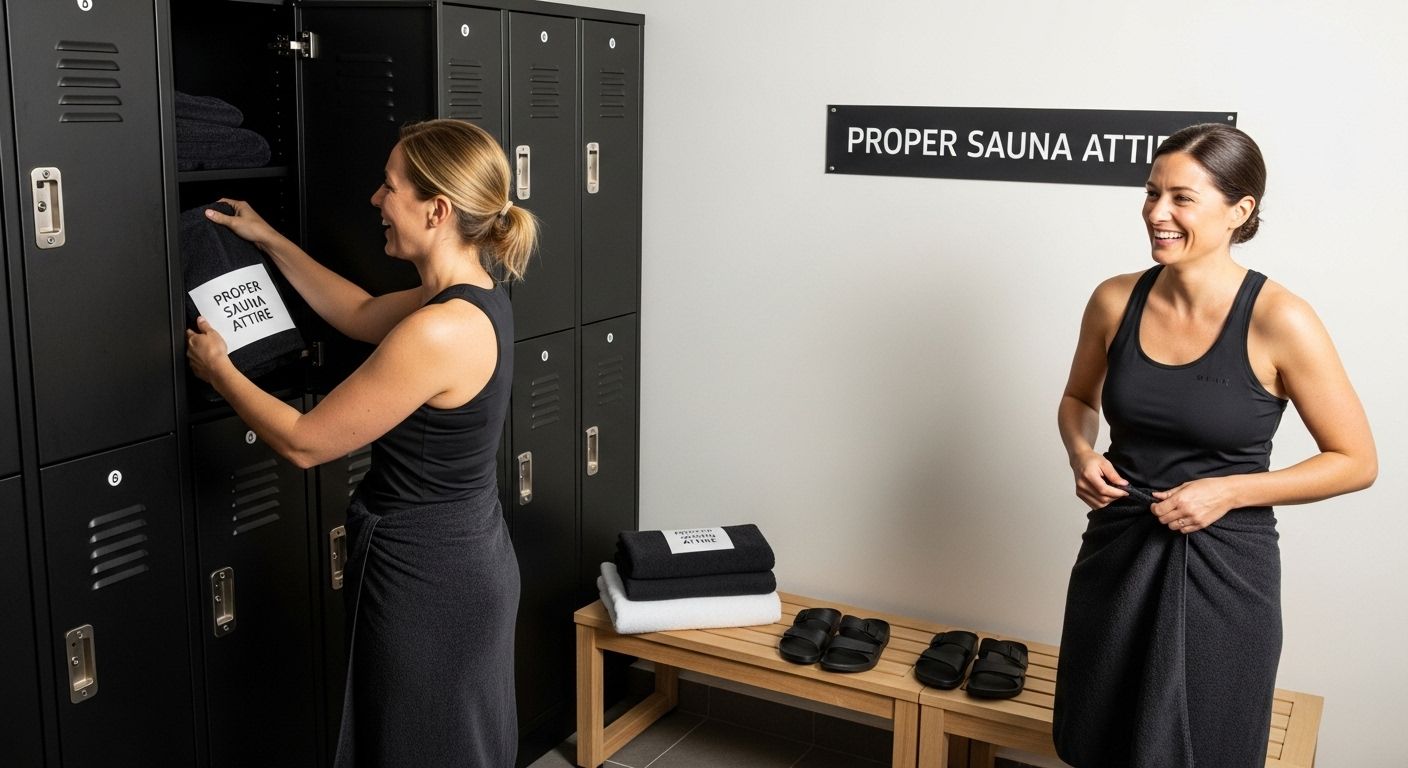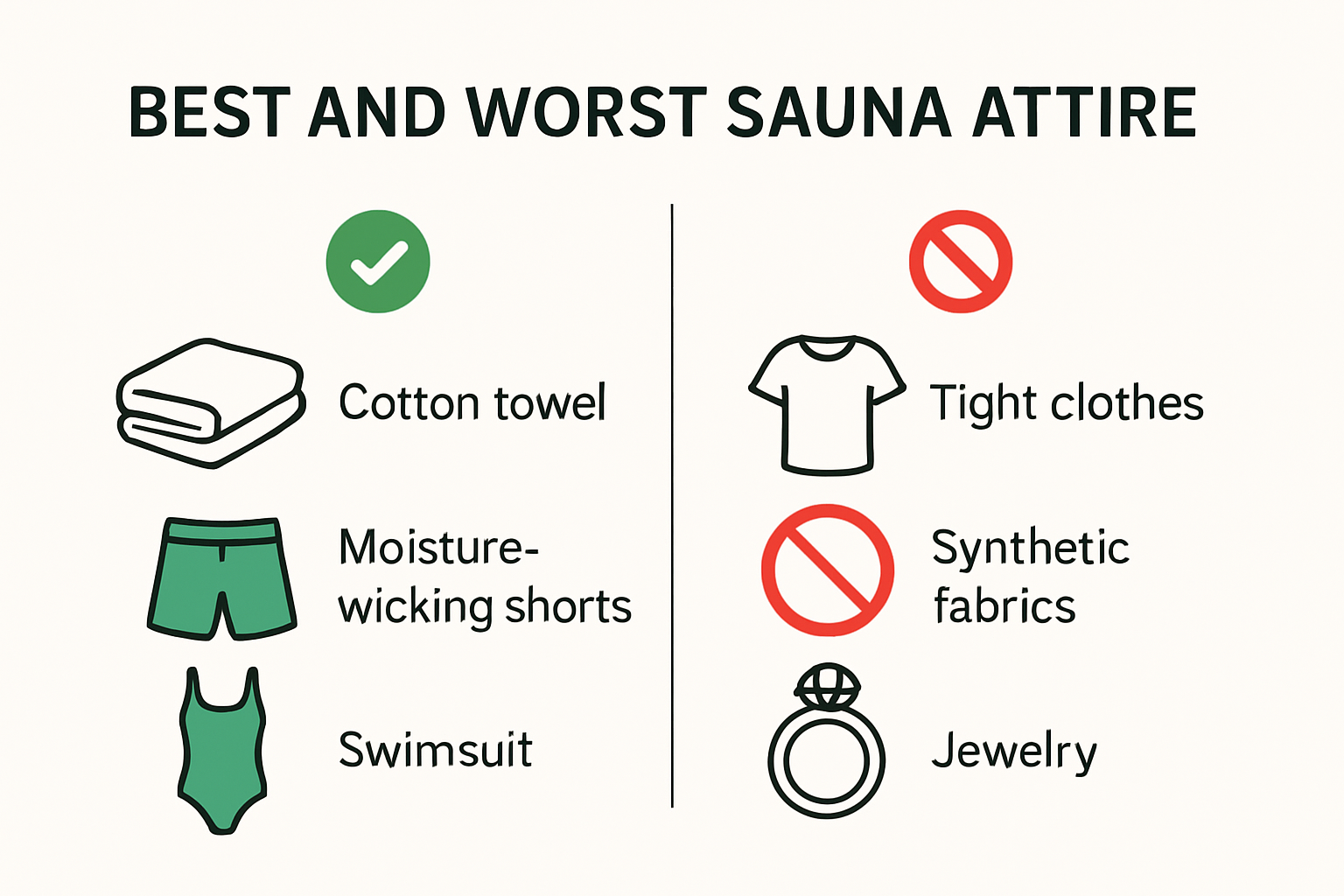
What to Wear in Sauna: Best Clothing and Tips

Choosing what to wear in a sauna might sound simple at first. Most people are surprised to learn that your clothing choice can make or break the entire experience. In fact, materials like cotton and specialized moisture-wicking fabrics can boost comfort and safety in temperatures that easily reach 180°F or higher. Instead of grabbing just any old gym shorts or swimsuit, picking the right attire could be the difference between deep relaxation and feeling lightheaded or overheating. Ready to rethink your sauna outfit?
Table of Contents
- Understanding Proper Sauna Attire Choices
- Top Materials and Clothing Best for Saunas
- What Not to Wear and Common Mistakes
- Tips for a Safe and Comfortable Sauna Experience
Quick Summary
| Takeaway | Explanation |
|---|---|
| Choose breathable fabrics for comfort | Opt for cotton or moisture-wicking materials that allow air circulation and effective perspiration. |
| Avoid tight and synthetic clothing | Tight clothing can trap heat and prevent sweating, potentially causing overheating during your sauna session. |
| Bring a clean towel for hygiene | Always sit on a dry towel to maintain cleanliness and avoid direct contact with shared sauna surfaces. |
| Monitor your body’s response to heat | Pay attention to signs of discomfort, such as dizziness or rapid heartbeat, and exit the sauna if necessary. |
| Stay hydrated before and after use | Drink water to prevent dehydration, especially before entering the sauna for a session. |
Understanding Proper Sauna Attire Choices
Choosing the right attire for a sauna experience is crucial for comfort, hygiene, and maximizing the potential health benefits. The clothing you wear can significantly impact your overall sauna session, affecting everything from body temperature regulation to personal comfort and safety.
Fabric and Material Considerations
When selecting what to wear in a sauna, the fabric becomes a critical decision. Natural materials like cotton and lightweight breathable fabrics are typically recommended. North Carolina State University’s Wellness guidelines emphasize the importance of appropriate clothing in shared sauna spaces, highlighting that the right material can make a substantial difference in your experience.
Cotton is particularly beneficial because it allows your skin to breathe and absorbs moisture effectively. Synthetic materials like polyester or nylon are less ideal, as they can trap heat and prevent proper perspiration. Lightweight, loose-fitting clothing helps maintain airflow and prevents overheating, which is essential in the high-temperature sauna environment.
Recommended Sauna Attire Options
The most appropriate sauna attire varies depending on the specific type of sauna and personal preference. Wikipedia’s sauna research suggests several practical options for what to wear:
- Swimwear: A well-fitted swimsuit is often the most versatile choice, providing coverage while allowing maximum skin breathability.
- Lightweight Shorts: Gym or athletic shorts made from moisture-wicking materials can be comfortable and practical.
- Towel Coverage: Using a clean towel to sit on and potentially wrap around yourself provides both hygiene and comfort.
It is important to note that some traditional saunas, particularly in European settings, may have different clothing norms. In many Nordic countries, for instance, saunas are often enjoyed without clothing, though this practice varies widely based on cultural context and specific facility rules.
Safety and Hygiene Considerations
Beyond personal comfort, clothing choices in a sauna have significant hygiene implications. Always bring a clean, dry towel to sit on, which helps maintain cleanliness and prevents direct contact with shared surfaces. Avoid wearing shoes or outdoor clothing inside the sauna, as these can introduce dirt and bacteria.
Additionally, be mindful of the fabric’s heat resistance. Thick or non-breathable materials can lead to excessive sweating and potential discomfort. A lightweight, loose-fitting garment that allows your skin to breathe will provide the most comfortable and beneficial sauna experience.
To help you quickly compare suitable and unsuitable sauna attire, the following table summarizes the main fabric/material options, their key characteristics, and suitability for sauna use:
| Material/Fabric | Key Characteristics | Sauna Suitability |
|---|---|---|
| Cotton | Breathable, absorbent, soft, may retain heat | Good (Comfortable) |
| Moisture-wicking blends | Quick-drying, high breathability, regulates heat | Excellent |
| Polyamide-based fabrics | High thermal conductivity, cools quickly | Very Good |
| Thick synthetics (e.g., nylon, polyester w/o venting) | Low breathability, traps heat | Poor |
| Tencel | Sustainable, high air permeability, cooling effect | Excellent |
| Heavy, dark materials | Retains heat, low air flow | Poor |
| Specialized sauna wear | Loose, lightweight, often advanced synthetics | Excellent |
Remember that individual tolerance to heat varies, so listen to your body and adjust your clothing accordingly. Staying hydrated and paying attention to how you feel are just as important as what you wear when enjoying a sauna session.

Top Materials and Clothing Best for Saunas
Selecting the optimal materials for sauna clothing goes beyond mere fashion choices. The right fabric can significantly enhance your comfort, regulate body temperature, and improve overall sauna experience. Understanding the scientific properties of different textiles becomes crucial in making informed decisions about what to wear in a sauna.
Performance Fabric Characteristics
Research from the National Center for Biotechnology Information highlights the critical role of fabric properties in thermal management. Tencel, a sustainable fabric derived from wood pulp, demonstrates exceptional performance in high-temperature environments. Its high air permeability and low water vapor resistance create a cooling effect that can be particularly beneficial during sauna sessions.
Polyamide-based fabrics present another interesting option. Scientific analysis of sportswear materials reveals that these fabrics possess higher thermal conductivity, which means they can more effectively dissipate heat. This property makes them an excellent choice for individuals seeking quick heat release and improved comfort in intense thermal environments like saunas.
Moisture Management and Breathability
Breathability is a paramount consideration when choosing sauna attire. Moisture-wicking fabrics play a crucial role in maintaining comfort during high-temperature experiences. Advanced textile research demonstrates that polyester blends with enhanced water vapor permeability can significantly improve overall comfort.
Key fabric characteristics to prioritize include:
- Quick-drying capabilities: Prevents excessive moisture retention
- Lightweight construction: Allows maximum air circulation
- Minimal heat retention: Helps regulate body temperature
Cotton, while comfortable, presents mixed performance in sauna environments. Its lower thermal conductivity means it might retain more heat compared to synthetic alternatives. However, its natural breathability and soft texture still make it a viable option for those prioritizing comfort over advanced thermal management.
Specialized Sauna Wear Recommendations
For individuals seeking optimal sauna experiences, consider specialized clothing designed specifically for high-heat environments. Lightweight, loose-fitting garments made from advanced synthetic materials offer the best combination of comfort and performance. Compression-style shorts or lightweight athletic wear constructed from moisture-wicking fabrics can provide an ideal balance between coverage and breathability.
Avoid heavy, thick materials that impede natural sweating and heat dissipation. Synthetic blends that incorporate cooling technologies can provide an additional layer of comfort, helping to manage body temperature more effectively during intense sauna sessions.
Remember that individual preferences and tolerance vary. Experimenting with different materials and observing how your body responds will help you identify the most comfortable sauna attire for your specific needs. Prioritize fabrics that allow your skin to breathe, manage moisture effectively, and support your body’s natural cooling mechanisms.
What Not to Wear and Common Mistakes
Avoiding certain clothing and accessories in a sauna can prevent potential health risks and ensure a safe, comfortable experience. Understanding what not to wear is just as important as selecting appropriate sauna attire. Many individuals unknowingly make clothing choices that can compromise their safety and overall sauna enjoyment.
Prohibited Clothing and Materials
The Mayo Clinic strongly advises against wearing tight-fitting clothing or synthetic materials that restrict body movement and impede natural cooling processes. Tight garments can trap heat, prevent proper sweating, and potentially lead to overheating or heat-related discomfort.
Synthetic materials like polyester or nylon that do not breathe well can create a significant barrier to your body’s natural temperature regulation. These fabrics can become uncomfortably hot, cause excessive sweating, and prevent moisture evaporation. Instead, opt for loose, breathable materials that allow your skin to perspire and cool down naturally.

Dangerous Accessories and Jewelry
Harvard Health Publishing provides critical guidance about accessories in high-temperature environments. Metal jewelry poses a serious risk in saunas, as these items can rapidly heat up and potentially cause burns when in direct contact with skin. This includes:
- Rings: Metal bands can become extremely hot and cause skin irritation
- Necklaces: Metallic chains can heat quickly and create uncomfortable burning sensations
- Watches: Metal watch bands and cases can reach dangerous temperatures
- Piercings: Metal body jewelry can become extremely hot and potentially cause injury
Additional Sauna Clothing Mistakes
Beyond material selection, several common mistakes can compromise your sauna experience. Wearing makeup, heavy lotions, or sunscreen can block pores and prevent effective sweating. These products can also break down under high temperatures, potentially causing skin irritation or clogged pores.
Undergarments made from non-breathable materials can create uncomfortable moisture retention. Cotton underwear, while generally comfortable, might become heavy and uncomfortable when saturated with sweat. Consider moisture-wicking underwear or specialized athletic undergarments designed for high-heat environments.
Footwear is another critical consideration. Never wear outdoor shoes or street shoes inside a sauna. Not only is this unhygienic, but shoes can track dirt and bacteria into a shared space. If a facility requires foot protection, use clean, dedicated sauna slippers or go barefoot on a clean towel.
Dehydration is a significant risk in saunas, so avoid wearing clothing that might make you feel even warmer.
The following checklist table outlines key do’s and don’ts for common sauna attire and accessory choices to support your safety and comfort:
| Item/Practice | Safe for Sauna? | Notes |
|---|---|---|
| Tight-fitting clothing | No | Traps heat, impedes sweating |
| Loose, breathable clothing | Yes | Promotes air flow and comfort |
| Synthetic (nylon/polyester) | No | Low breathability, retains heat |
| Metal jewelry/accessories | No | Risk of burns and skin irritation |
| Clean towel (to sit on) | Yes | Essential for hygiene |
| Outdoor shoes/footwear | No | Unhygienic, not allowed in sauna |
| Moisture-wicking underwear | Yes | Helps manage sweat effectively |
Dark, thick materials absorb more heat and can increase your body temperature unnecessarily. Light-colored, loose-fitting clothing helps reflect heat and allows for better air circulation.
Remember that individual comfort varies. What works for one person might not work for another. Always listen to your body, stay hydrated, and be prepared to adjust your clothing if you feel uncomfortable. A successful sauna session is about creating an environment that promotes relaxation, detoxification, and overall wellness.
Tips for a Safe and Comfortable Sauna Experience
Creating a safe and enjoyable sauna experience requires more than just selecting the right clothing. Proper preparation, awareness of your body’s signals, and understanding key safety guidelines can transform your sauna session from potentially uncomfortable to genuinely therapeutic.
Preparation and Pre-Sauna Considerations
The CDC’s National Institute for Occupational Safety and Health emphasizes the importance of wearing appropriate clothing to reduce heat-related risks. Before entering a sauna, consider these preparatory steps:
- Hydration: Drink plenty of water before your sauna session to prevent dehydration
- Light Meal: Avoid heavy meals immediately before sauna use
- Clean Body: Take a quick shower to remove oils, lotions, and sweat
- Towel: Bring a clean, dry towel to sit on and potentially wipe away perspiration
Ensure you are in good physical condition before entering a sauna. Individuals with certain health conditions, such as heart problems, low or high blood pressure, or those taking medications that affect heat tolerance, should consult a healthcare professional before using a sauna.
Body Awareness and Safety Monitoring
The Cleveland Clinic provides critical guidance on recognizing your body’s response to heat. Paying attention to physical signals is crucial for a safe sauna experience. Watch for warning signs such as:
- Dizziness
- Weakness
- Difficulty breathing
- Chest pain
- Unusually rapid heartbeat
If you experience any of these symptoms, exit the sauna immediately. Start with shorter sessions, typically 5-10 minutes, and gradually increase duration as your body adapts. First-time sauna users should be particularly cautious and listen carefully to their body’s responses.
Maximizing Comfort and Therapeutic Benefits
Beyond safety, several strategies can enhance your sauna experience. Position yourself strategically within the sauna to manage heat exposure. Lower areas tend to be cooler, while higher benches provide more intense heat. If you are new to saunas or sensitive to high temperatures, start on a lower bench and move up gradually.
Alternate between heat exposure and cooling periods. Many experienced sauna users practice a cycle of heating and cooling, which can help improve circulation and provide a more balanced experience. Some people take a cool shower or step outside between sauna sessions to regulate body temperature.
Mental preparation is equally important. Approach your sauna session with a relaxed mindset. Deep, controlled breathing can help manage the heat and promote relaxation. Consider using meditation techniques or simply focusing on your breath to enhance the therapeutic aspects of your sauna experience.
Remember that personal tolerance varies widely. What works for one person might not work for another. Stay attuned to your body, respect its limits, and prioritize your comfort and safety above all. A successful sauna session should leave you feeling refreshed, relaxed, and rejuvenated, not exhausted or overwhelmed.
Frequently Asked Questions
What should I wear in a sauna for optimal comfort?
To maximize comfort in a sauna, choose breathable fabrics like cotton or moisture-wicking materials for your clothing. Avoid tight and synthetic garments that can trap heat and impede sweating.
Is it acceptable to wear a swimsuit in the sauna?
Yes, a well-fitted swimsuit is a practical choice for sauna use, as it provides coverage while allowing for skin breathability. However, you may also opt for lightweight, loose-fitting shorts or a clean towel.
What materials should I avoid wearing in the sauna?
Avoid tight-fitting clothing and synthetic materials like polyester or nylon that do not breathe well. These can trap heat and prevent effective sweating, leading to discomfort or overheating.
How can I ensure hygiene while using a sauna?
Always bring a clean, dry towel to sit on and avoid wearing outdoor shoes or clothing inside. This helps maintain cleanliness and prevents the introduction of dirt and bacteria into the sauna environment.
Elevate Your Sauna Experience With the Right Gear and Best Life Sauna
Are you tired of feeling overheated or uncomfortable because you chose the wrong clothing for your sauna session? Many people struggle to find attire that offers true breathability and comfort. It is easy to overlook the difference the right fabrics and accessories make for heat management, skin comfort, and hygiene. With proper preparation and informed choices, you can unlock real relaxation and wellness benefits every time you step into your sauna.

Transform your approach by exploring the carefully curated products and wellness solutions at Best Life Sauna. Step beyond basic advice and discover premium saunas, accessories, and wellness upgrades designed to enhance every session. See why more people trust Best Life Sauna for superior comfort, safety, and support. Visit the Best Life Sauna shop now to find your essentials and enjoy exclusive offers that can change how you sauna for good.

